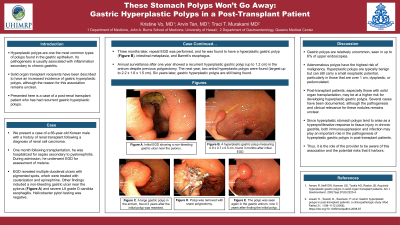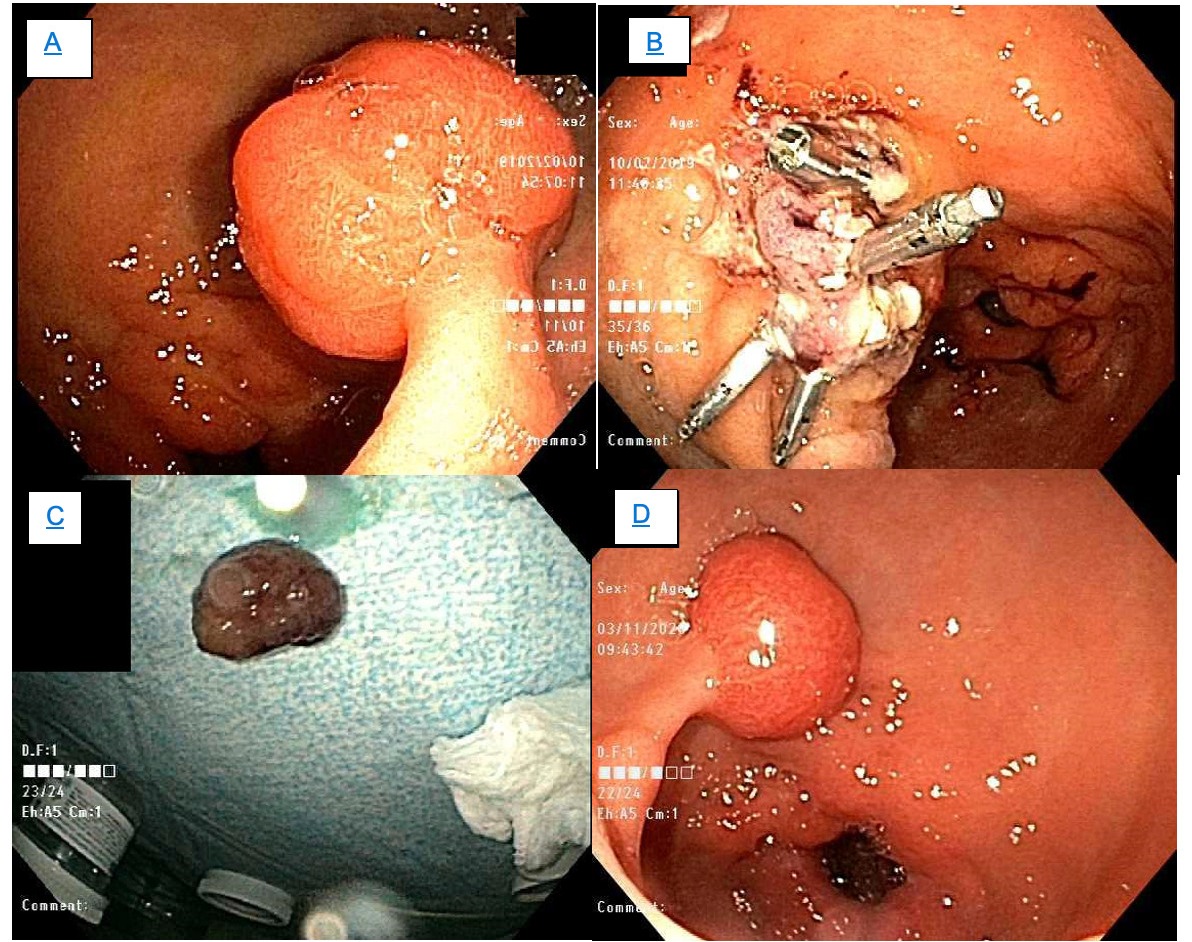Tuesday Poster Session
Category: Stomach
P4233 - These Stomach Polyps Won’t Go Away: Gastric Hyperplastic Polyps in a Post-Transplant Patient
Tuesday, October 24, 2023
10:30 AM - 4:00 PM PT
Location: Exhibit Hall

Has Audio
- KV
Kristine Vo, MD
University of Hawaii, John A. Burns School of Medicine
Honolulu, HI
Presenting Author(s)
Kristine Vo, MD1, Arvin Tan, MD1, Traci T. Murakami, MD2
1University of Hawaii, John A. Burns School of Medicine, Honolulu, HI; 2Queen's Medical Center - West Oahu, Ewa Beach, HI
Introduction: Hyperplastic polyps are one the most common types of polyps found in the gastric epithelium. Its pathogenesis is usually associated with inflammation secondary to chronic gastritis. Solid organ transplant recipients have been described to have an increased incidence of gastric hyperplastic polyps, although the reason for this association remains unclear. Presented here is a case of a post-renal transplant patient who has had recurrent gastric hyperplastic polyps.
Case Description/Methods: We present a 66-year-old Korean male with a history of renal transplant following a diagnosis of renal cell carcinoma. One month following transplantation, he was hospitalized for sepsis secondary to pyelonephritis. During admission, he underwent EGD for assessment of melena. EGD revealed multiple duodenal ulcers with pigmented spots, which were treated with cauterization and epinephrine. Other findings included a non-bleeding gastric ulcer near the pylorus [MTT1] and severe LA grade D candida esophagitis. Helicobacter pylori testing was negative. Repeat EGD was performed three months later, and he was found to have a hyperplastic gastric polyp (0.9 x 0.7 x 0.5 cm), intestinal metaplasia, and Barrett’s esophagus. Annual surveillance after one year showed a recurrent hyperplastic gastric polyp (up to 1.2 cm) in the antrum despite previous polypectomy. The next year, two antral hyperplastic polyps were found (largest up to 2.2 x 1.6 x 1.5 cm). Six years later, gastric hyperplastic polyps are still being found.
Discussion: Gastric polyps are relatively uncommon, seen in up to 6% of upper endoscopies. Adenomatous polyps have the highest risk of malignancy. Hyperplastic polyps, on the other hand, are typically benign but can still carry a small neoplastic potential, particularly in those that are over 1 cm, dysplastic, or pedunculated. Post-transplant patients, especially those with solid organ transplantation, may be at a higher risk for developing hyperplastic gastric polyps. Several cases have been documented, although the pathogenesis and clinical relevance for these nodules remains unclear. Since hyperplastic stomach polyps tend to arise as a hyperproliferative response to tissue injury in chronic gastritis, both immunosuppression and infection may play an important role in the pathogenesis of hyperplastic gastric polyps in post-transplant patients. Thus, it is the role of the provider to be aware of this association and the potential risks that it harbors.

Disclosures:
Kristine Vo, MD1, Arvin Tan, MD1, Traci T. Murakami, MD2. P4233 - These Stomach Polyps Won’t Go Away: Gastric Hyperplastic Polyps in a Post-Transplant Patient, ACG 2023 Annual Scientific Meeting Abstracts. Vancouver, BC, Canada: American College of Gastroenterology.
1University of Hawaii, John A. Burns School of Medicine, Honolulu, HI; 2Queen's Medical Center - West Oahu, Ewa Beach, HI
Introduction: Hyperplastic polyps are one the most common types of polyps found in the gastric epithelium. Its pathogenesis is usually associated with inflammation secondary to chronic gastritis. Solid organ transplant recipients have been described to have an increased incidence of gastric hyperplastic polyps, although the reason for this association remains unclear. Presented here is a case of a post-renal transplant patient who has had recurrent gastric hyperplastic polyps.
Case Description/Methods: We present a 66-year-old Korean male with a history of renal transplant following a diagnosis of renal cell carcinoma. One month following transplantation, he was hospitalized for sepsis secondary to pyelonephritis. During admission, he underwent EGD for assessment of melena. EGD revealed multiple duodenal ulcers with pigmented spots, which were treated with cauterization and epinephrine. Other findings included a non-bleeding gastric ulcer near the pylorus [MTT1] and severe LA grade D candida esophagitis. Helicobacter pylori testing was negative. Repeat EGD was performed three months later, and he was found to have a hyperplastic gastric polyp (0.9 x 0.7 x 0.5 cm), intestinal metaplasia, and Barrett’s esophagus. Annual surveillance after one year showed a recurrent hyperplastic gastric polyp (up to 1.2 cm) in the antrum despite previous polypectomy. The next year, two antral hyperplastic polyps were found (largest up to 2.2 x 1.6 x 1.5 cm). Six years later, gastric hyperplastic polyps are still being found.
Discussion: Gastric polyps are relatively uncommon, seen in up to 6% of upper endoscopies. Adenomatous polyps have the highest risk of malignancy. Hyperplastic polyps, on the other hand, are typically benign but can still carry a small neoplastic potential, particularly in those that are over 1 cm, dysplastic, or pedunculated. Post-transplant patients, especially those with solid organ transplantation, may be at a higher risk for developing hyperplastic gastric polyps. Several cases have been documented, although the pathogenesis and clinical relevance for these nodules remains unclear. Since hyperplastic stomach polyps tend to arise as a hyperproliferative response to tissue injury in chronic gastritis, both immunosuppression and infection may play an important role in the pathogenesis of hyperplastic gastric polyps in post-transplant patients. Thus, it is the role of the provider to be aware of this association and the potential risks that it harbors.

Figure: A. A large gastric polyp in the antrum. B and C. Polyp was removed with snare polypectomy. D. The polyp was seen again in the gastric antrum 1-year later.
Disclosures:
Kristine Vo indicated no relevant financial relationships.
Arvin Tan indicated no relevant financial relationships.
Traci Murakami indicated no relevant financial relationships.
Kristine Vo, MD1, Arvin Tan, MD1, Traci T. Murakami, MD2. P4233 - These Stomach Polyps Won’t Go Away: Gastric Hyperplastic Polyps in a Post-Transplant Patient, ACG 2023 Annual Scientific Meeting Abstracts. Vancouver, BC, Canada: American College of Gastroenterology.
